Analysis
Art Market Reset: Riding the Waves of Change
The art market is in the midst of a radical sea change. What can buyers and sellers learn from the cresting waves?
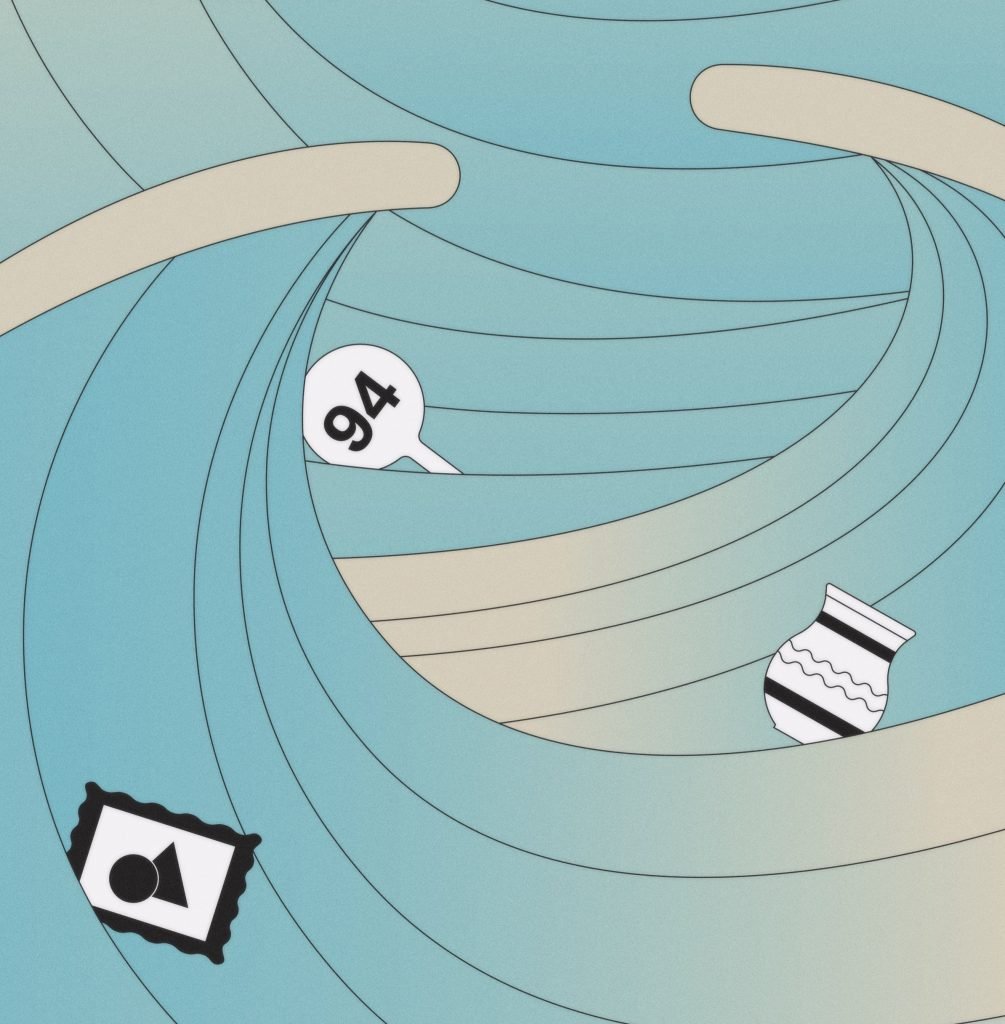
This article is part of the Artnet Intelligence Report Mid-Year Review 2024. Our analysis of the first half of the year’s market trends provides a data-driven overview of the current state of the art world, highlighting auction results and trends, and spotlights the artists and artworks shaping the dialogue.
Until recently, Mihail Lari was the kind of engaged and passionate collector the art world loves. He cultivated relationships with artists, whose work he acquired in depth. He bid on art at charity auctions. He was the chairman of the board of advisors at the Hammer Museum, in Los Angeles, and had access to coveted works by both emerging and established artists.
But over the past two years, Lari has scaled back his engagement with the art world. He stepped down as the Hammer’s chairman, gave away more than 50 artworks from his collection to various museums, and significantly cut down on new purchases. While he used to buy art every month, he has bought only one piece since the start of the year. Instead, he’s thrown himself behind a congressional campaign in Palm Springs, California, fundraising to elect 39-year-old Democrat Will Rollins and unseat the district’s longtime Republican incumbent.
“The music has stopped,” said Lari, 58, a former tech entrepreneur. “The world is so precarious right now that one wants to focus on what’s really important. To accumulate art for the sake of accumulating art is just so five years ago.”
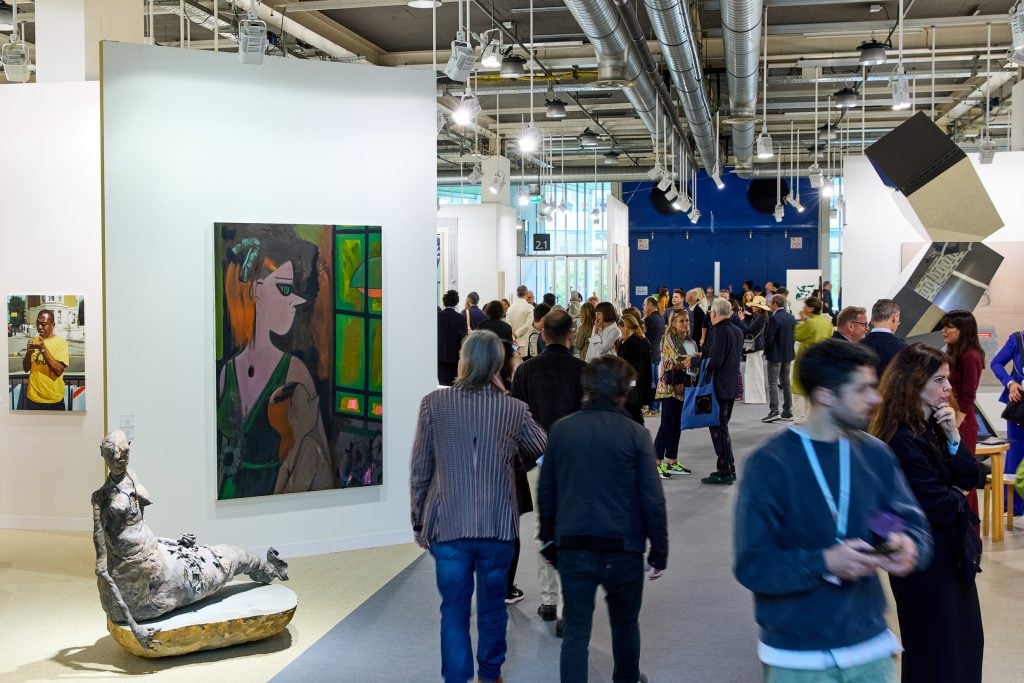
At Art Basel in Switzerland in June, Hauser and Wirth’s president, Iwan Wirth, noted “a more humane pace.” Photo courtesy of Art Basel
Lari is one of many self-admitted art addicts who have pulled back on recreational art spending. Their retreat, coupled with a downturn in art consumption in China and the bursting of the speculative bubble for emerging artists, has rocked the art market. Confusingly, all this is happening as the stock market hovers near an all-time high and a lot of people are making a lot of money. For many, it’s a time to pause, take stock, and reset.
“Have you been at the beach and the waves are coming in two different directions at you?” art adviser Wendy Cromwell asked. “Those waves meet, and it’s a rip current. We are in that moment right now in the art world. A lot of people are waiting on the sidelines because they don’t want to go in the water.”
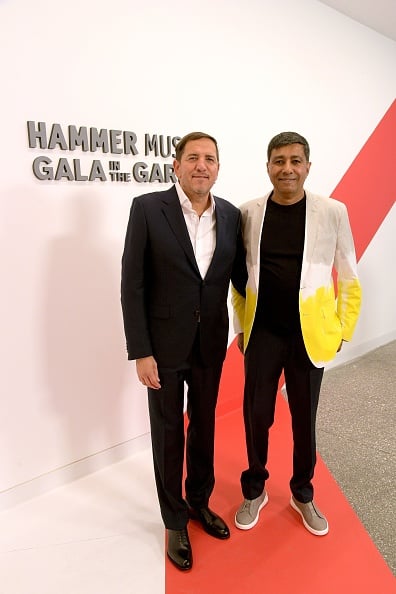
Scott Murray and Mihail Lari at the Hammer Museum Gala, May 4, 2024 in Los Angeles, California. Photo by Charley Gallay/Getty Images for Hammer Museum.
A combination of factors is to blame for the current impasse, including the plummeting resale values of once desirable art, stubbornly high interest rates, and the upcoming presidential election in the U.S.—not to mention the Israel-Gaza war and the Russia-Ukraine war, which have removed swaths of buyers, with some alienated and others sanctioned. Speculators, who poured into the art market during the pandemic, are getting out and selling works they bought at the top of the market for pennies on the dollar.
Galleries across the board have had a rough time selling art for the past two years, with many collectors saying that primary prices have climbed too high. The most recent Art Basel was more disappointing than initial reports indicated, dealers said. The pressure has been getting to galleries: More than a dozen in New York have closed over the past 12 months,¹ including blue-chip players like Mitchell-Innes and Nash² and popular younger destinations like Simone Subal³ and David Lewis.4 Major galleries started laying off staff.5 Many others are hanging on by a hair. There’s an expectation that more will shutter this year unless the slump miraculously ends, which is hard to imagine given current interest rates, dealers said.
Auction sales are down, too. They fell to $5.05 billion during the first half of 2024, a nearly 30 percent decline from the same period last year, according to the Artnet Price Database. The only worse result in the past decade was the $3.3 billion total for the first half of 2020, which included the terrifying early months of the pandemic. By comparison, according to Artnet’s data, global art auctions peaked at $8.6 billion during the first half of 2014. (Since the pandemic, the highest first-half total was $7.96 billion, in 2022.)
Christie’s saw a 22 percent drop in sales, to $2.1 billion, during the first six months of the year as a result of the “challenging macroeconomic environment,” the auction house’s chief executive officer, Guillaume Cerutti, told reporters on July 6.6
Sotheby’s didn’t break out its fine art figures, but a spokesperson said its auctions realized $2.34 billion, including cars and real estate (make what you will of that unorthodox grouping). Meanwhile, Phillips was down 9 percent year-over-year, with $373 million in sales.7
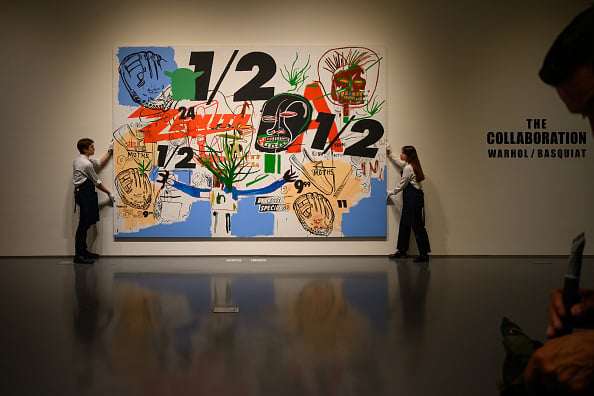
An untitled 1984 painting by Andy Warhol and Jean-Michel Basquiat went for $19.4 million at Sotheby’s New York in May. Photo by Alexi Rosenfeld/Getty Images.
“If a big estate came up, and it was of the quality of Yves Saint Laurent’s or Paul Allen’s, it would do incredibly well, even now,” advisor Philip Hoffman, CEO of the Fine Art Group, said. “The downside is that the interest rates of 5 percent or upwards are punishing. So people are saying, ‘If I get 5 or 6 percent fixed and art has been dropping in value, I’ll hold off buying art.’”
Sure, there are reports of eye-watering private purchases by hedge-fund billionaire Ken Griffin and his peers. Asian billionaires (outside of China) are ready to deploy their cash, too, should something exceptional become available, Hoffman said. But back on Planet Earth, mere mortal art folk are struggling. Even among the ultrawealthy, uncertainty prevails.
Doom Porn
“The art world economically has ground to a halt,” a gallerist with spaces in New York and Los Angeles said. “A memo is going around to not buy art.”
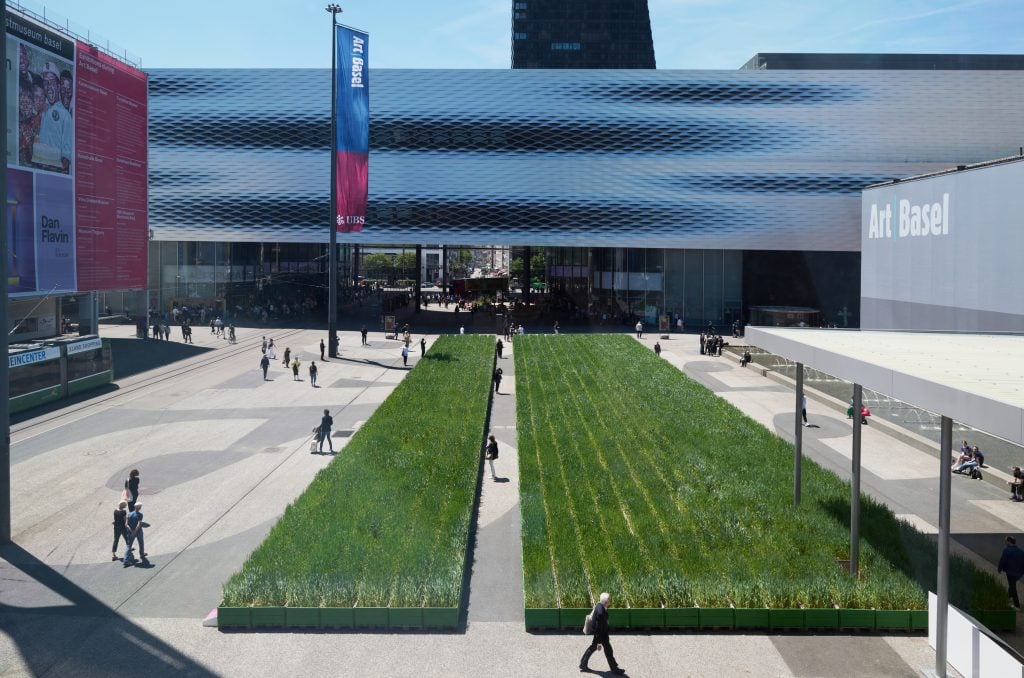
Art Basel in Switzerland in June. Courtesy of Art Basel
All the gloomy talk has prompted pushback from certain quarters. During Art Basel’s VIP opening, Iwan Wirth, cofounder of the mega-gallery Hauser and Wirth, registered his displeasure.
“In spite of the ‘doom porn’ currently circulating in the art press and along gossip grapevines, we are very confident in the art market’s resilience,” Wirth wrote in an email that contained a litany of sales.8 As a nod to the challenging market conditions, Wirth noted “a more humane pace” of activity.
Market players are adjusting to the slower pace by rethinking how they operate and adopting new approaches to generate excitement around art while deemphasizing talk of money.
For one example of this reset, look at the five-month-long exhibition that artist Christopher Wool recently organized in a thoroughly noncommercial setting—a derelict 18,000-square-foot office space in Manhattan’s Financial District—with none of its 74 works for sale.9
About a decade ago, Wool was a king of the contemporary-art hill. Billionaire collectors clamored for his new paintings, and his resale prices soared as high as $30 million in 2015.10
Since then, Wool has been spending more time in Marfa, Texas, far from the New York art epicenter. Long uneasy about the commercialization of his art, he has been starving his market by restricting the availability of what buyers most crave: his paintings. Instead, he’s been making lower-priced works on paper and sculpture.
With many new pieces on view in New York, collectors have been angling to get access—in vain, so far, dealers said. “His fundamental motivation is to speak to something that’s broader than the market,” a person familiar with Wool’s thinking said. “He’s helping his audience see his vision and his values.” Wool is not the only creator grappling with a downturn. “Artists who had lived healthy lives, having a show every few years, always selling out, and having a very devoted buyership, for so many of these artists, the market completely stopped,” power advisor Allan Schwartzman remarked at the Talking Galleries New York conference in April.11
This alarming situation is the result of overproduction, astronomical primary prices, and tastes shifting away from white male artists toward figures who have been historically overlooked because of their gender and race.
Top-selling talents like Rudolf Stingel, Sterling Ruby, and Nicolas Party have seen dramatic drops in auction sales, according to the Artnet Price Database.
“The smartest way for an artist to reset is to go underground,” an auction executive said, “to reinvent yourself and come up with a new idea. The worst thing to do is to keep churning out shows.”
No Reserve
The collapse in resale prices for once-coveted art has become a touchy subject.
“The assumption was that if you were spending hard-earned money on these works, especially when artists had a lot of buzz and were represented by good galleries, the works had monetary value,” said Lari.
The lack of resale opportunities surprised many collectors and has become something of a joke among his friends, Lari said. “We all laugh about it,” he said. “When you needed to sell something, there was absolutely no market for it.”
He considers himself lucky. “We don’t desperately need to sell,” Lari said of himself and his husband of 24 years. “We over-indulged like most people in the art world. Now we are spring cleaning the collection.”
In recent years, it was easy to over-indulge. Money was cheap. You could easily borrow against your investments. But when interest rates went up, you suddenly had to use real money to make purchases.
“There’s been a huge shakeout of speculators,” the auction exec said. “You are getting more people trying to get out—and they are willing to take a loss.”
Take the case of María Berrío’s painting La Cena (2012), which fetched $441,000 at Christie’s in May,12 less than a third of its purchase price of $1.6 million just two years before.13
Matters have only gotten more alarming since then. At a Phillips auction in New York on July 17, works by well-known artists like David LaChapelle, Sam Gilliam, Wendy Park, Dan Colen, and Petra Cortright were offered without reserves, indicating that their owners were willing to sell at any price.14
Pieces with reserves by hot young artists like Cristina BanBan and Tunji Adeniyi-Jones went unsold, as did ones by veterans like Peter Doig and Ross Bleckner and established mid-career figures like Shinique Smith, Analia Saban, and José Parlá.
A 2018 painting by Vaughn Spann, Dalmatian No. 6 (Martha’s Vineyard), failed to find a buyer at $30,000 to $40,000,15 a 40 percent drop in estimate since November, when its owner tried—and failed—to offload it at $50,000 to $70,000.16 Works from this series by the 32-year-old artist were sold at auction for as much as $151,200 in 2022.17
Then there was Nate Lowman’s 2012 painting Ciao Bella, whose owner was trying for a third time to sell it. That consignor had bought it from Lowman’s solo show at Massimo De Carlo gallery in Milan in 2012 and, three years later, put it up at Phillips at $80,000 to $120,000, finding no takers.18 The owner tried again in 2020, adjusting expectations down by 50 percent, to $40,000 to $60,000.19 That didn’t work, either. July saw another sales attempt—at $15,000 to $20,000—which also flopped.20
(Note to seller: Maybe try it with no reserve next time?)
This latest failure played out as Massimo De Carlo was asking $220,000 for Lowman’s new works (one sale was reported in December at Art Basel Miami Beach). David Zwirner was asking $80,000 to $350,000 for Lowman’s works at Frieze New York and didn’t report any sales.
Market Disaster
It’s no surprise that buyers are freaked out and that sales are slow to nonexistent at galleries, dealers said.
“Literally no one is buying art,” one gallery owner said. One of his clients, a major collector, is now shopping for $500 art at antiques stores and picking up works directly from artists’ studios at half the price galleries charge.
Another client hasn’t paid for purchases made in February.
“The market has been a disaster,” said Jim Hedges, a private dealer and former financier who has been selling Warhol Polaroids since 2010 and claimed never to have “had a period as bad as this year.”
Those Warhol photographs have performed well through stock-market dips and political uncertainty. Created by one of the top names in the market, they are priced modestly, as contemporary art goes, at $25,000 to $75,000, with a few exceptions tagged as high as $200,000.
“That has all served to insulate me from typical volatility,” Hedges said. “This year is different, and for that matter, everyone I know is struggling.”
He’s grateful for every sale, he said, including one to the wife of a billionaire “who asked for six months to pay.” (In July, Hedges was sued by Jack Shainman Gallery, alleging that he owes it almost $300,000 for work that he sold on consignment. “We strongly disagree with the claim,” Hedges’s gallery said in a statement, which adds that the parties had been “in the midst of business negotiations.”)21
The market conditions present opportunities for buyers with cash and a discerning eye. Galleries are offering big discounts, and some have even lowered prices to move works, collectors said.
Still, many buyers are turning to auctions for even better deals. Lari said he found a work by an artist he collects in depth (owning 19 works) at auction for 10 percent of the price on the primary market.
Belgian collector Alain Servais has also had luck finding deals at auction. Two years ago, he fell in love with the bedazzled Vodou flags of Haitian artist Myrlande Constant at the Venice Biennale. Richly textured and humorous, they appeared in the main exhibition, “The Milk of Dreams,” curated by Cecilia Alemani. Servais asked Constant’s gallery about buying something for his collection. In December 2022, the gallery offered him a work from that year, composed of beads, sequins, and tassels on fabric, for $150,000. Servais found the price excessive and passed.
This July, he spotted a work by Constant from the late 2010s, La Sirene Dimant, in a Christie’s online auction, where it was estimated at $25,000 to $35,000.22 Servais went for it, winning the depiction of three mermaids sharing a festive meal for $37,800, including fees.
According to the Artnet Price Database, that established an auction record for Constant, just five of whose pieces have come to auction.
Servais felt “joyful” to have obtained the work at a price he considered fair, he said. “And joyful to be vindicated by resisting a price I found exaggerated in an artificial primary market.”
Palate Cleanser
The changing reality is starting to sink in with sellers who are agreeing to auction estimates that would have been considered unpalatable 12 or 24 months ago (and sometimes, as we saw, they are even willing to sell with no reserve).
Meanwhile, auction houses are trying to market art in fresh ways. For its big May sales in New York, Christie’s highlighted multimillion-dollar paintings of flowers (yes, flowers!) as an escape from the depressing state of the world.
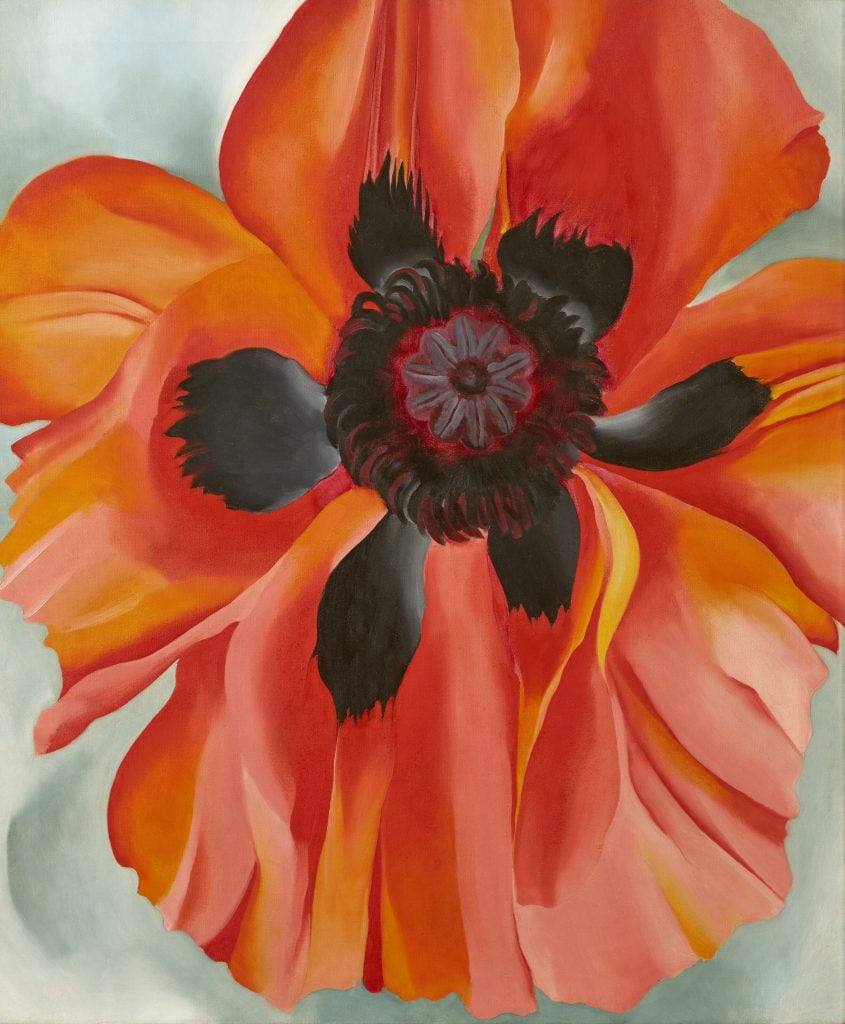
Georgia O’Keeffe, Red Poppy (1928). Courtesy of Christie’s Images, Ltd.
This paid off: Its top lot of the season was Andy Warhol’s 1964 Flowers, which fetched $35.5 million. Georgia O’Keeffe’s Red Poppy (1928) brought $16.5 million. Both prices (with fees) exceeded their high estimates.23 Galleries, for their part, are embracing collaboration as a strategy to get through the tough times. Shared booths have become more common at art fairs, and alternatives to corporate fairs, with lower participation fees (like Basel Social Club, Our Week in Seoul, Esther in New York),24 are proliferating.25
This summer, six Manhattan galleries banded together to open a sprawling venue, the Campus, in a former school in the small town of Claverack, in Upstate New York.26
The dealers’ original aim was to find affordable storage, but realizing that the 78,000-square-foot building could easily accommodate exhibitions, they tapped curator Timo Kappeller to organize an opening show with 80 artists. “It’s about presenting something in a new way and getting people excited,” said James Cohan, one of the partners.
Perhaps the current downturn will prove to be a painful but necessary palate cleanser.
The intensifying commodification of art has left an unpleasant taste in the mouths of even the most loyal patrons. They can enjoy their many years of acquisitions while putting a pause on opening their checkbooks.
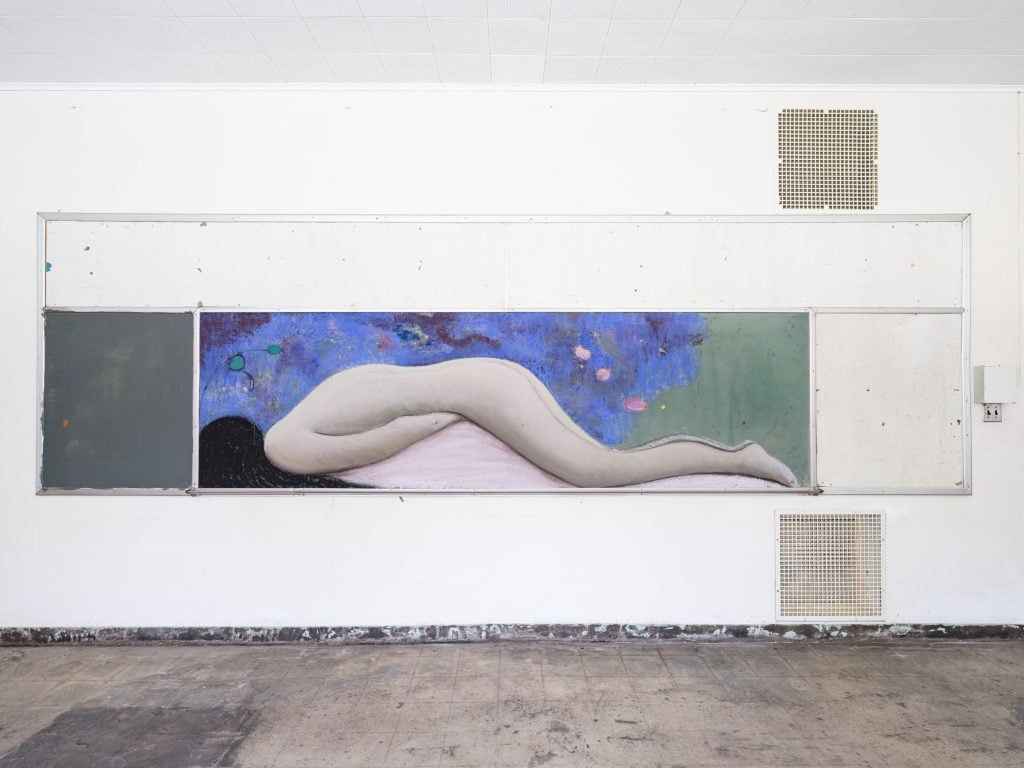
Installation view, work by Sanya Kantarovsky on view at The Campus, Claverack, New York. Courtesy of the artist. The Campus / Photo by Yael Eban and Matthew Gamber.
Take Lari, who is focused on politics but still enjoys experiencing art without feeling the need to buy more. A large red-neon sculpture of the upside-down word “America” by Glenn Ligon glows on a 40-foot wall of his house. In another room, Marilyn Minter’s 2014 video Smash shows a plus-size model smashing glass. He doesn’t rule out purchasing new art again, but it needs to be powerful, life-changing.
“We are being much more selective,” Lari said. “It’s less about the buying and more about the experience. We don’t want to be hoarders anymore.”
Endnotes
1. https://news.artnet.com/market/a-hard-look-at-the-tumultuous-new-york-gallery-scene-as-dealers-shutter- and-move-2494448
2. https://news.artnet.com/market/mitchell-innes-and-nash-transition-2503630
3. https://news.artnet.com/market/canada-gallery-partner-wet-paint-2497343
4. https://news.artnet.com/market/influential-new-york-dealer-david-lewis-will-close-his-doors-after-11-years-2492564
5. https://www.artnews.com/art-news/news/david-zwirner-cuts-digital-team-reorganizes-e-commerce-start-up-platform-1234713221/ https://www.theartnewspaper.com/2024/07/31/white-cube-in-london-lets-go-of-38-invigilatorsmost-of-them-artists-and-students
6. https://news.artnet.com/market/christies-reports-steep-drop-in-auction-totals-for-first-half-of-2024-2513026
7. https://puck.news/newsletter_content/ken-griffins-scalp-phillips-373m-1h-the-end-of-the-arb-era/
8. https://www.theartnewspaper.com/2024/06/11/art-basel-shrugs-off-doom-porn-talk-with-blockbuster-first-day-of-sales
9. https://news.artnet.com/market/christopher-wools-financial-district-show-2513095
10. Artnet Price Database
11. https://news.artnet.com/market/cutting-art-prices-debate-2464639
12. https://www.christies.com/en/lot/lot-6482478
13. https://www.sothebys.com/en/buy/auction/2022/contemporary-curated-5/la-cena-2
14. https://www.phillips.com/auctions/auction/NY011024
15. https://www.phillips.com/detail/vaughn-spann/NY011024/53
16. https://www.phillips.com/detail/vaughn-spann/NY010923/359
17. Artnet Price Database
18. Ibid.
19. Ibid.
20. https://www.phillips.com/detail/nate-lowman/NY011024/100?fromSearch=lowman&searchPage=1
21. https://www.artnews.com/art-news/news/jack-shainman-gallery-sues-collector-jim-hedges-1234713058/
22. https://onlineonly.christies.com/s/first-open-post-war-contemporary-art/myrlande-constant-b-1968-167/228225
23. Artnet Price Database
24. https://news.artnet.com/art-world/esther-art-fair-report-2477095
25. https://www.nytimes.com/2024/03/21/arts/design/art-basel-hong-kong-alternatives.html
26. https://news.artnet.com/art-world/the-campus-opening-upstate-new-york-2508491






